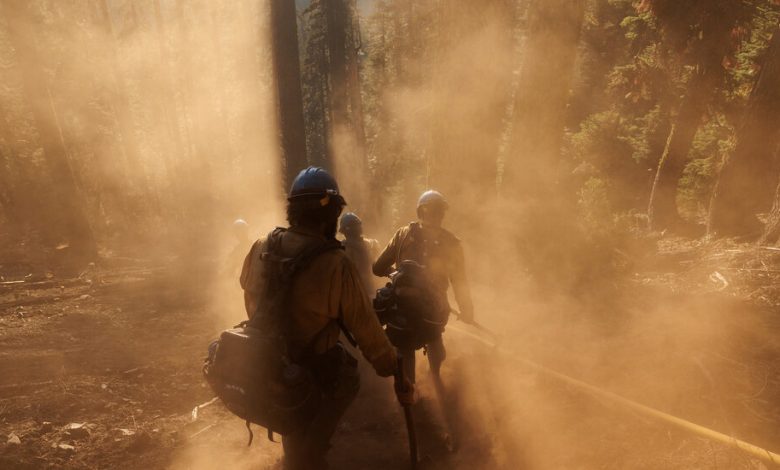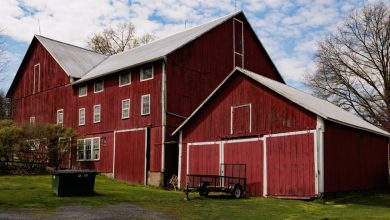Two Years With America’s Elite Firefighters




It’s been a relatively quiet wildfire season in the United States.
Fewer acres have burned than at any time in the last quarter-century.
Yet it was anything but “quiet” for the Tallac Hotshots, as they battled some of the most challenging blazes across the country.
Supported by
SKIP ADVERTISEMENT
Two Years With America’s Elite Firefighters
Hotshot fire crews work on the front lines of the biggest wildfires in the American West. We rode along with them.
-
Share full article
Photographs by Max Whittaker
By Thomas Fuller
Max Whittaker has covered wildfires for over 20 years, and spent two seasons documenting the Tallac Hotshots and other crews.
Early this summer, while many Americans were gathering for Fourth of July barbecues, the Tallac Hotshots were in triple-digit heat in Arizona, fighting a wildfire for 14 straight days and sleeping on the ground next to their trucks.
The federal firefighting crew had only three days off before darting to a fire raging in a thickly wooded evergreen forest in Oregon.
They then decamped to the Klamath National Forest across the border in California, working overnight in dense and steep terrain filled with poison oak.
After a few days of rest, they were dropped by helicopter in early September into some of the most remote wilderness in Northern California to battle a fire blazing despite near-freezing temperatures.
As always, there was no leisurely summer vacation — no real vacation at all — for the crew.

The fireline on the Happy Camp Complex fire in California in August.
There are more than 100 “hotshot” teams across the United States, most of them part of the U.S. Forest Service. The Times spent two years following the Tallac Hotshots and other crews.
The name, dating back to the 1940s, describes firefighters who go to the hottest, most treacherous and most technically challenging parts of the conflagrations that plague the American West.
Even during relatively slow years, like this one, their work can go largely unseen by the wider world.
On their two-week deployments — sometimes they go for three without a break if a fire is particularly urgent — hotshot crews often have no access to cellphone signals or showers.
Instead of fire engines and hoses, they use hand tools and chain saws to carve out dirt tracks to choke the progress of a fire.
A standard shift on a fire is 16 hours. Crew members often sleep in the open air.
After weeks without bathing, team members say it can take two or three showers to scrub all the grime and soot that stay caked on like a chimney sweeper out of Dickens.
“It’s really physical but it’s extremely mental, too,” said Kyle Betty, the superintendent of the Tallac Hotshots, which are based near Lake Tahoe in California and named after Mount Tallac.
Even after 22 years as a federal firefighter, Mr. Betty says he still has trouble gauging who will make it and who will drop out.
“The things that you see, the things that you face — every day you have to get up and do it again,” he said. “You have to be relentless.”



The soundtrack to their jobs is the loud crack of flaming branches plummeting to the forest floor.
Sap-filled trees sizzle with a steady hiss like green logs in a fireplace.
Fully engulfed pine trees roar ominously as they light up the night sky.
If the crew works nights, forest service administrators sometimes send trailers filled with bunk beds — cryo chambers, the crew calls them — so that members can sleep with some air-conditioning, and the lights off.
Coffee helps. Many crew members carry packets of instant coffee in their fire gear. On long shifts, they empty the powder into their mouths and wash it down with water from their flasks.
Nineteen men and two women make up the Tallac Hotshots, hailing from across the country.
Michael Frogner, 29, who runs a chain saw for the crew, used to be a door-to-door vacuum cleaner salesman in Arizona.
Chris Kingston, 24, a rookie, graduated from Bowdoin College in Maine with a degree in economics.
Elsa Gaule, 37, one of the crew’s captains, spent her earliest years in Alaska in a house without a toilet or running water. She is known for laughing hard and loud when one of her crew members loses his footing and starts rolling down a hill.
But she would also do anything for her “fire fam,” as she calls her crew. “I spend more time with this group then I do with my family,” she said.
A dozen years ago, when Ms. Gaule was on a crew fighting the Motor fire west of Yosemite National Park — named as such because it spread after a motor home caught fire — a giant log barreled down the steep slope where she was working, knocked her over and rolled across her neck and back.
On another night, she was hit in the hip by a flaming boulder. The moss on the rock had ignited and looked like a fireball out of a movie.
They’re reminders of the extreme dangers of the job, especially at a time when desiccated forests and high temperatures brought on by climate change are making wildfires more intense.
One blaze that haunts hotshot crews is the Yarnell Hill fire in Arizona, which killed 19 members of the Granite Mountain Hotshots in 2013.
As a fast-moving wildfire overtook them, they deployed emergency shelters, small tent-like coverings that are meant to shield them from the flames and heat.
A government investigation concluded that the fire exceeded 2,000 degrees Fahrenheit.
“It’s an extremely dangerous job with a lot of hazards and a lot of risk,” said Mr. Betty, the Tallac Hotshots superintendent. “It’s not summer camp.”
It’s also not a good way to get rich. Mr. Kingston, the economics graduate, says he often thinks of his college friends in New York or Boston who work highly paid white-collar jobs.
Being a hotshot, he said, “is Wall Street hours for not-Wall-Street money.”



Base pay for entry-level federal firefighters is $16 an hour, according to Brian Rhodes, the deputy fire director in California at the Forest Service.
Overtime and hazard pay somewhat compensate for the relatively low hourly wage, hotshots say.
But there is still a yawning gap between what federal firefighters and state firefighters earn in agencies like Cal Fire, California’s state fire agency, which has much more generous overtime policies.
A report published this year by the University of Washington concluded that on average, the base monthly pay of federal firefighters, including hotshots, was about 41 percent less than their counterparts in state agencies.
The pay disparity is at the heart of the Wildland Firefighter Paycheck Protection Act, legislation that would raise the base pay of entry level federal firefighters by 42 percent. The bill is currently pending before Congress.
“They are the premier firefighting force in the U.S.,” Evan Pierce, one of the authors of the University of Washington report, said of hotshots. “But they are working longer and in more dangerous conditions — for less pay.”
Still, the Tallac Hotshots say they’re drawn to the outdoors, the deep sense of camaraderie and the solidarity with their fellow crew members. Some want to be tested in ways that other jobs cannot do.
“I’m not a very good sit-at-a-desk person,” Ms. Gaule said. “Until my knees and back give out, I’ll continue doing this.”
Dylan Ney, 32, says he revels in the physicality of the work. Like most people on the crew, he expends so many calories that he sheds 25 pounds every fire season.
But being away for such long deployments means that he misses key family milestones. He wasn’t there when his two young boys took their first steps. His wife sent him videos that he watched during breaks from the fire line.
He has a few more years in him as a hotshot, he said, but not more. “I will miss the woods,” he said.
The crew has worked most of this November in Tennessee tending to a series of fires fueled by extreme drought. Ms. Gaule said Thanksgiving would very possibly be spent swinging hand tools on the fire lines.
But she’s relentlessly optimistic. “Thanksgiving with the fire fam,” she said. “It’s all good.”




